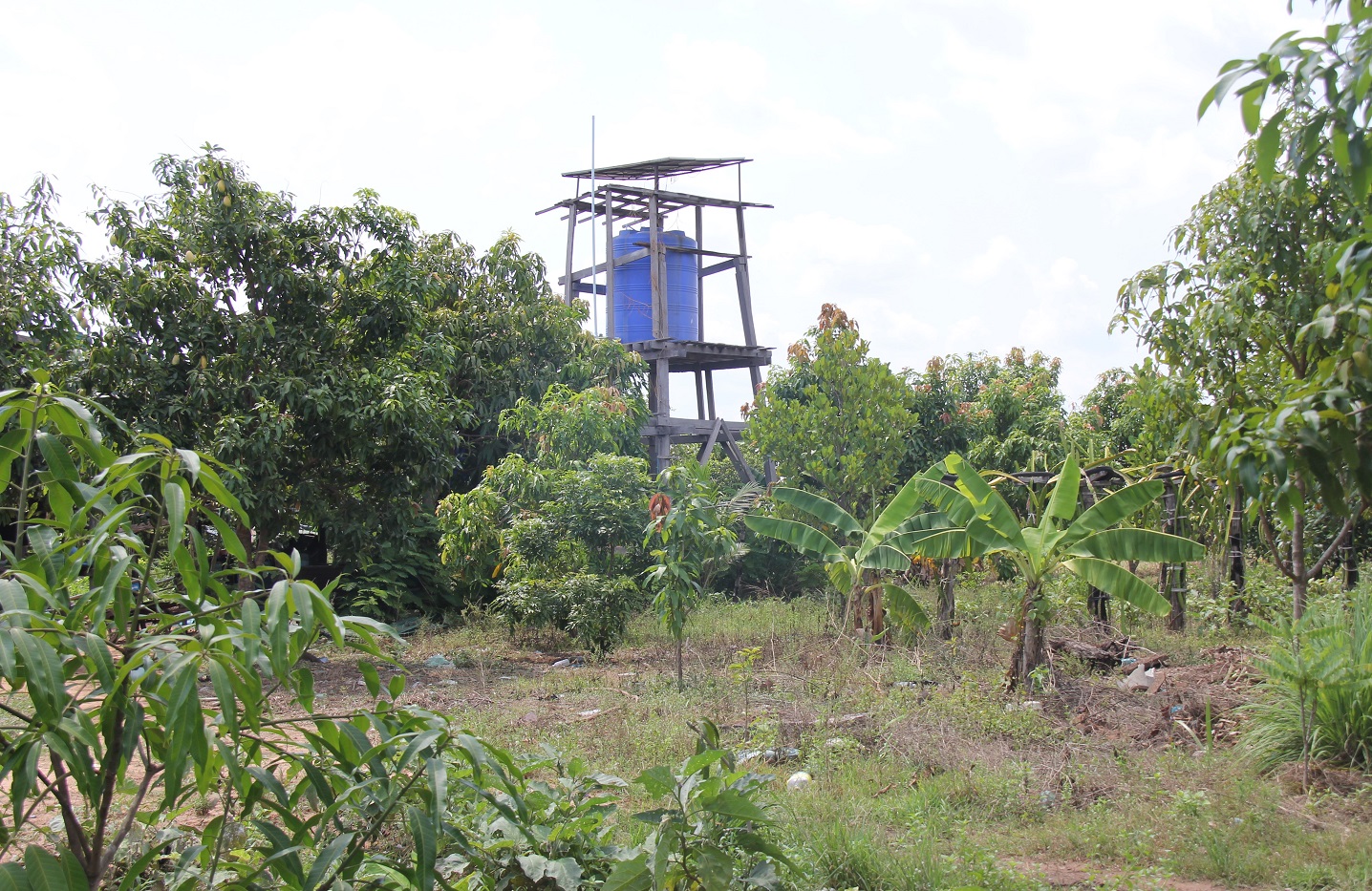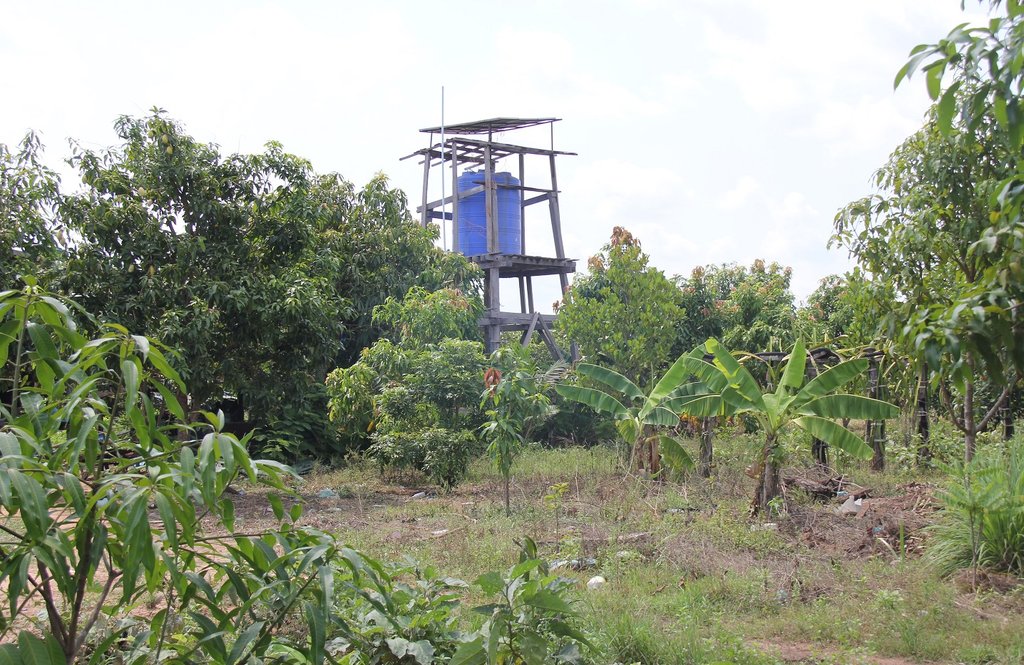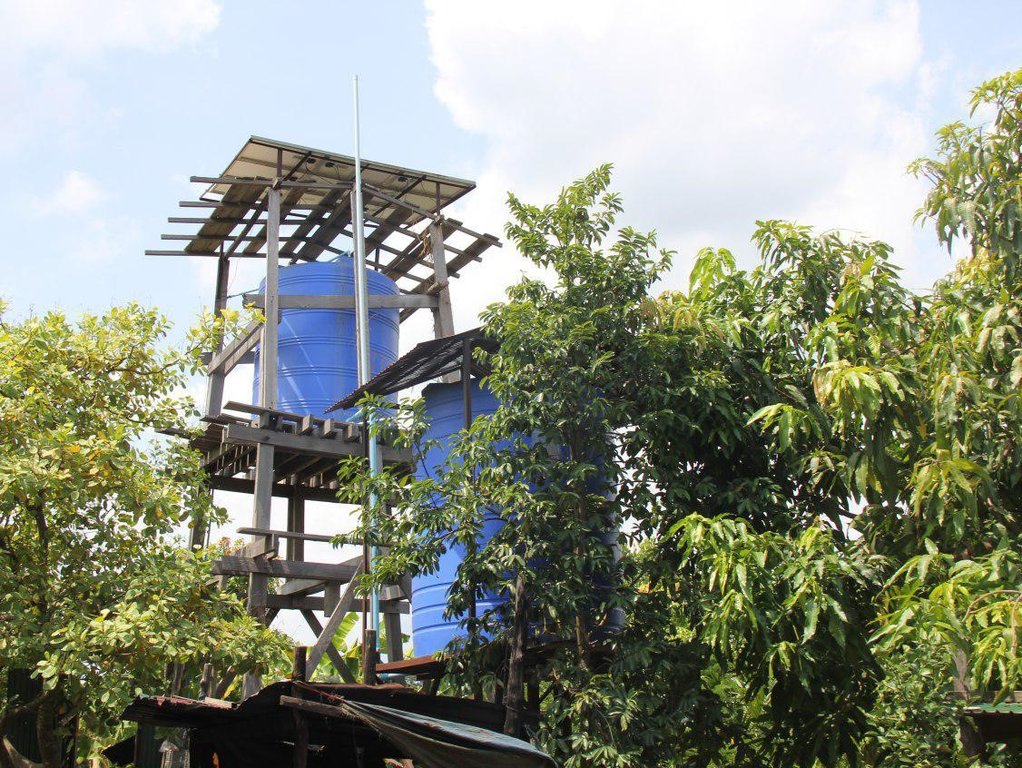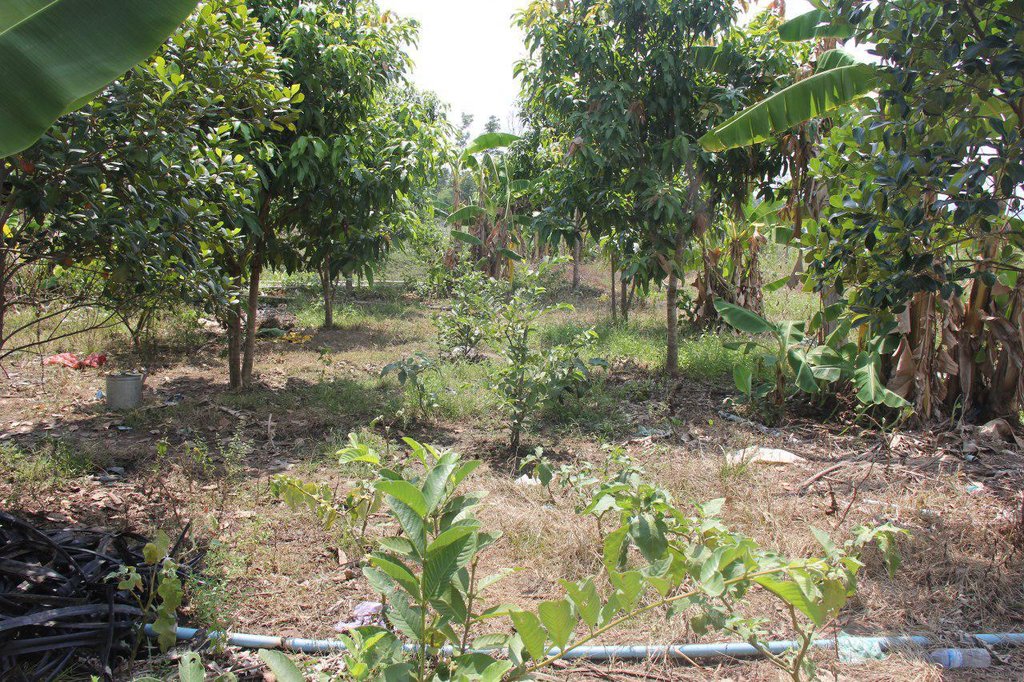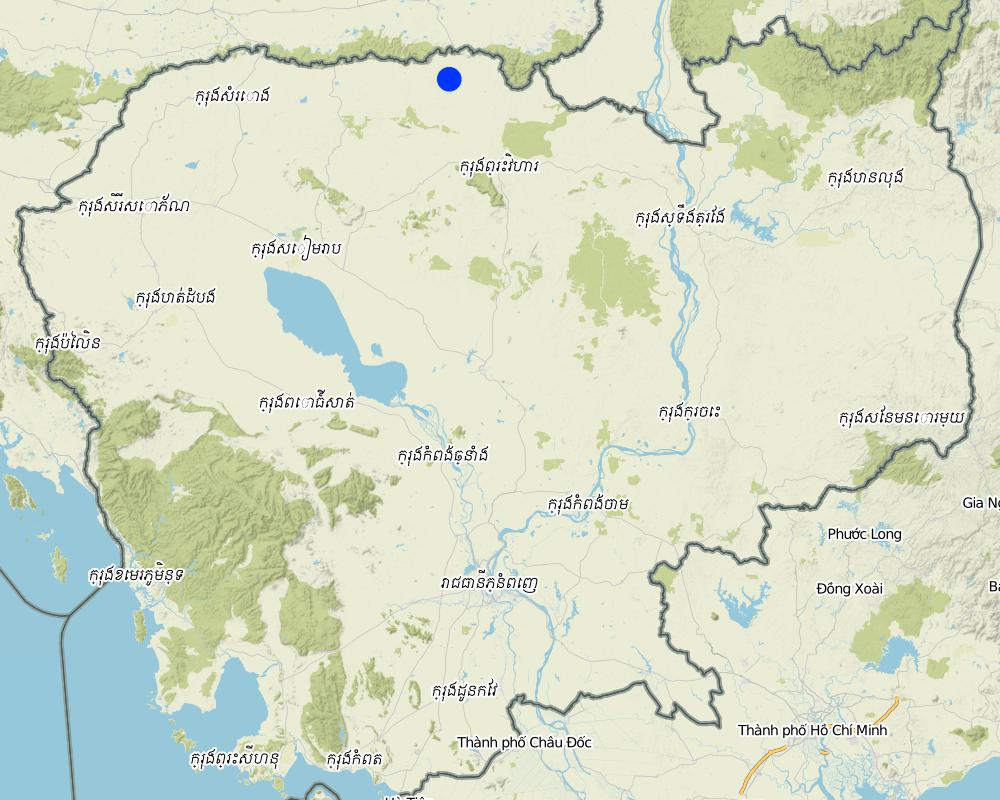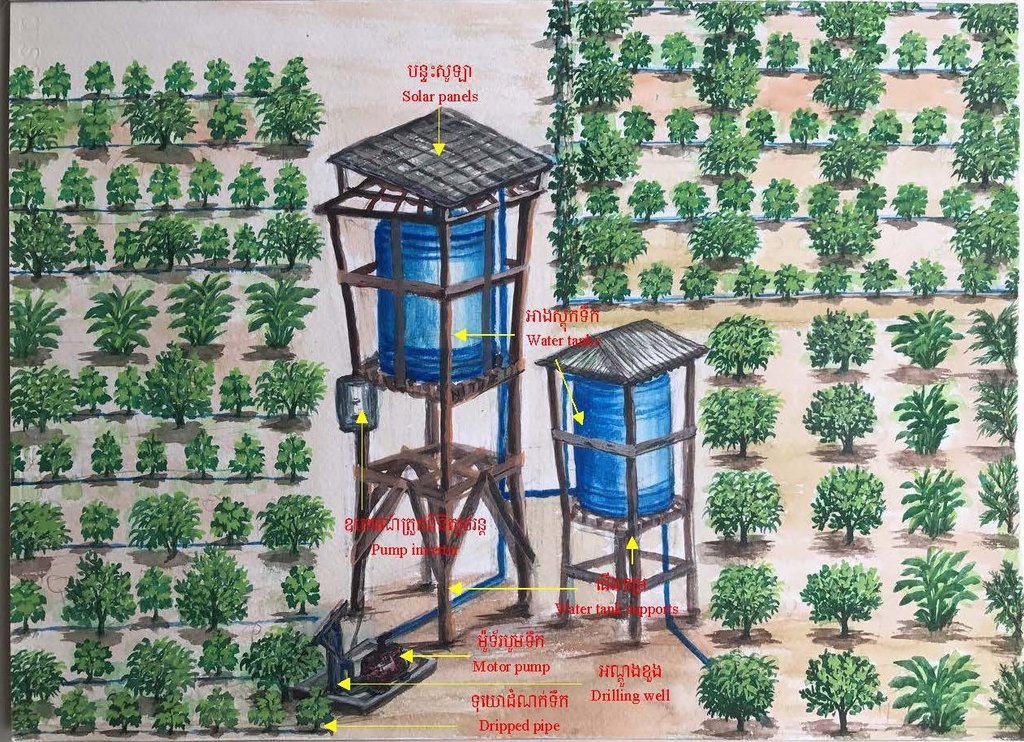ប្រព័ន្ធបូមទឹកប្រើថាមពលព្រះអាទិត្យដើម្បីបន្ស៊ាំនឹងការប្រែប្រួលអាកាសធាតុ [كمبوديا]
- تاريخ الإنشاء:
- تحديث:
- جامع المعلومات: Sok Pheak
- المحررون: Sophea Tim, Navin Chea
- المراجعون: Nimul CHUN, Ursula Gaemperli, Alexandra Gavilano
ប្រព័ន្ធសូឡាបូមទឹក
technologies_3214 - كمبوديا
عرض الأقسام
توسيع الكل طي الكل1. معلومات عامة
1.2 تفاصيل الاتصال بالأشخاص الرئيسيين لمصدر المعلومات والمؤسسات المشاركة في تقييم وتوثيق التقنية
الشخص (الأشخاص) الرئيسي لمصدر المعلومات
مستخدم الأرض:
ម៉ៅ សារ៉ាត់
កសិករ
كمبوديا
អ្នកផ្សព្វផ្សាយឃុំ:
ថុន ភារៈ
មន្ត្រីផ្សព្វផ្សាយឃុំ
كمبوديا
មន្ត្រីការិយាល័យកសិកម្ម រុក្ខាប្រមាញ់ និងនេសាទស្រុកជាំក្សាន្ត:
ឆ្លាត ប្រាជ្ញ
ការិយាល័យកសិកម្ម រុក្ខាប្រមាញ់ និងនេសាទស្រុកជាំក្សាន្ត
كمبوديا
ប្រធានការិយាល័យកសិកម្ម រុក្ខាប្រមាញ់ និងនេសាទស្រុកគូលែន:
ប្រធានការិយាល័យកសិកម្ម រុក្ខាប្រមាញ់ និងនេសាទស្រុករវៀង:
មន្ត្រីមន្ទីរកសិកម្ម រុក្ខាប្រមាញ់ និងនេសាទខេត្តព្រះវិហារ:
اسم المشروع الذي سهّل توثيق/تقييم التقنية (إذا كان ذلك على صلة)
Scaling-up SLM practices by smallholder farmers (IFAD)اسم المؤسسة (المؤسسات) التي سهلت توثيق/تقييم التقنية (إذا كان ذلك على صلة)
Royal University of Agriculture (RUA) - كمبوديا1.3 الشروط المتعلقة باستخدام البيانات الموثقة من خلال WOCAT
يوافق جامع المعلومات والشخص (لاشخاص) الرئيسي لمصدر المعلومات على الشروط المتعلقة باستخدام البيانات الموثقة من خلال WOCAT:
نعم
1.4 إعلان بشأن استدامة التقنية الموصوفة
هل التقنية الموصوفة هنا تمثل مشكلة فيما يتعلق بتدهور الأراضي، بحيث لا يمكن إعلانها تقنية مستدامة لإدارة الأراضي؟:
كلا
2. وصف تقنيةالإدارة المستدامي للأراضي
2.1 وصف مختصر للتقنية
تعريف التقنية:
សូឡាបូមទឹកជាបច្ចេកទេសមួយដែលប្រើប្រាស់បន្ទះសូឡាសម្រាប់ទាញយកប្រភពថាមពលពីព្រះអាទិត្យ ហើយបំលែងជាថាមពលអគ្គិសនីដើម្បីដំណើរការម៉ូទ័រសម្រាប់បូមទឹកពីប្រភពនានារួមទាំងប្រភពទឹកក្រោមដីផងដែរ។ សូឡាបូមទឹកអាចកាត់បន្ថយការចំណាយ និងមិនមានបញ្ចេញឧស្ម័ន (CO2) ដែលជាជម្រើសល្អនៃការបង្កើនភាពធន់ទ្រាំ និងរួមចំណែកការកាត់បន្ថយការប្រែប្រួលអាកាសធាតុ។
2.2 وصف تفصيلي للتقنية
الوصف:
ប្រព័ន្ធបូមទឹកដោយប្រើថាមពលព្រះអាទិត្យ គឺជាការស្រាវជ្រាវមួយដោយប្រើប្រាស់បន្ទះសូឡាសម្រាប់ទាញយកពន្លឺព្រះអាទិត្យបង្កើតជាថាមពេលអគ្គិសនីសម្រាប់បូមទឹក។ ការប្រើសូឡាបូមទឹកជាជម្រើសដ៏ល្អមួយដើម្បីចូលរួមកាត់បន្ថយការប្រែប្រួលអាកាសធាតុ។ កសិករនៅភូមិធម្មជាតិសម្តេចតេជោ ហ៊ុន សែន ឃុំស្រអែម ស្រុកជាំក្សាន្ត ខេត្តព្រះវិហារ ពីមុនបានប្រើប្រាស់ទឹកស្រះជាប្រភពសម្រាប់ស្រោចស្រពដំណាំរបស់គាត់ ប៉ុន្តែការប្រើប្រាស់មិនបានផ្តល់ទឹកគ្រប់គ្រាន់ទៅតាមតម្រូវការទេ។ ដោយឃើញពីបញ្ហាកង្វះខាតនេះទើបមានអង្គការសេដាក (CEDAC) បានអនុវត្តន៍គម្រោងមួយនៅក្នុងតំបន់ហើយក៏បានផ្តល់អណ្តូងទឹកមួយដល់ប្រជាកសិករនៅក្នុងឃុំនេះនៅឆ្នាំ ២០១១ ដើម្បីដោះស្រាយបញ្ហាខ្វះខាតទឹក។ ក្រោយមកនៅឆ្នាំ ២០១៤ មន្ទីរកសិកម្ម រុក្ខាប្រមាញ់ និងនេសាទខេត្តព្រះវិហារបានផ្តល់សូឡាបូមទឹកមួយឈុតសម្រាប់ដាំបន្លែក្រោមជំនួយឧបត្ថម្ភរបស់កម្មវិធីសកម្មភាពបន្ស៊ាំនឹងការប្រែប្រួលអាកាសធាតុដំណាក់កាលទី ២ ដែលបានអនុវត្តនៅក្នុងឃុំនេះ។ គម្រោងបានផ្តល់ប្រព័ន្ធសូឡាបូមទឹកប្រើថាមពលព្រះអាទិត្យចំនួន ៧ កន្លែង នៅក្នុងភូមិធម្មជាតិសម្តេចតេជោ ហ៊ុន សែន ហើយគម្រោងក៏បានតម្លើងប្រព័ន្ធសូឡាបូមទឹកមួយកន្លែងមានទីតាំងនៅផ្ទះរបស់ លោក ម៉ៅ សារ៉ាត់សម្រាប់ប្រើប្រាស់ទឹកដាំបន្លែ។ អណ្តូងស្នប់នេះមានលក្ខណៈពិសេសមួយដែលអាចដំណើរការបានបើទោះជាថាមពលរបស់វាមានការប្រែប្រួលក៏ដោយ។
ដើម្បីដំណើរការប្រព័ន្ធសូឡាបូមទឹកនេះត្រូវមានឧបករណ៏ជាធាតុផ្សំសំខាន់ៗមួយចំនួនដូចជា៖បន្ទះសូឡាដែលបានដាក់នៅខាងលើជើងទម្រឈើ ម៉ូទ័របូមទឹក ឧបករណ៍ត្រួតពិនិត្យចរន្ត អាងស្តុកទឹកដែលមានជើងទម្រ និងខ្សែភ្លើង។ ចំពោះការតម្លើងប្រព័ន្ធសូឡាបូមទឹកនេះ ជាដំបូងត្រូវខួងអណ្តូងទឹក ហើយដាក់ម៉ូទ័របូមទឹកចូលក្នុងអណ្តូង និងរៀបចំទុយោចែកចាយ។ បន្ទាប់មកទៀតត្រូវរៀបចំជើងទម្រសម្រាប់ដាក់អាងស្តុកទឹកចំនួន ២ ដែលមានកម្ពស់ ៤,៨ ម៉ែត្រ និង ២,០៤ ម៉ែត្រ រួចតម្លើងអាងស្តុកទឹក និងម៉ូទ័របូមសម្រាប់បូមទឹកមកស្តុកទុកក្នុងអាងស្តុកទឹក។ គាត់តម្លើងបន្ទះសូឡាចំនួន៩ដោយដាក់លើជើងទម្រខាងលើប្រអប់បញ្ជាម៉ូទ័របូមទឹកដើម្បីទាញយកថាមពលពន្លឺព្រះអាទិត្យមកប្រើប្រាស់ និងត្រួតពិនិត្យកម្ពស់ក្នុងអាងស្តុកទឹកដើម្បីចែកចាយទឹកដល់ដំណាំ និងប្រើប្រាស់ក្នុងគ្រួសារ។ អាងស្តុកទឹកមានចំណុះ៥០០០លីត្រចំនួន ២ ដែលប្រើប្រាស់សម្រាប់ដំណាំក្នុងសួនបន្លែ និងផ្គត់ផ្គង់ទឹកតាមផ្ទះចំនួន ៣ គ្រួសារនៅក្នុងភូមិផងដែរ។ ដោយសារតែមានឧបករណ៍ផ្គត់ផ្គង់ទឹកដែលធន់ទៅនឹងការប្រែប្រួលអាកាសធាតុ និងជួយកាត់បន្ថយការចំណាកស្រុកដោយកសិករងាកមកធ្វើកសិកម្មវិញ។
ប្រព័ន្ធសូឡាបូមទឹក គឺជាបច្ចេកទេសបូមទឹកដោយស្វ័យប្រវត្តិដែលទាញយកថាមពលព្រះអាទិត្យមកប្រើប្រាស់ដែលអាចចំណេញកម្លាំងពលកម្ម និងពេលវេលា កាត់បន្ថយការបំភាយឧស្ម័នទៅក្នុងបរិយាកាស និងអាចចែកចាយទឹកទៅតាមតំបន់ឆ្ងាយ។ នៅពេលគម្រោងបញ្ចប់បានបន្សល់ទុកប្រាក់ឧបត្ថម្ភចំនួន ២,០០០ ដុល្លា ទុកសម្រាប់ជុសជុលប្រព័ន្ទសូឡាបូមទឹក។ សហគមន៍ កសិកម្មធម្មជាតិនិងអភិវឌ្ឍន៍ជាយដែនបានគ្រប់គ្រង់ថវិកាដែលបានផ្តល់ជូនដោយប្រើប្រាស់ថវិកាបង្កើតជាឥណទានសម្រាប់សមាជិកសហគមន៍មានអាត្រាការប្រាក់២%ក្នុង១ខែហើយនៅពេល ដែលជុសជុលសហគមន៍បានបង្វិលថវិកាមកវិញ។ ម្យ៉ាងវិញទៀត បន្ទាប់ពីបានតម្លើងសូឡាបូមទឹកបានរយៈពេល ១ ឆ្នាំ លោក ម៉ៅ សារ៉ាត់ បានលក់ទឹកឱ្យកសិករផ្សេងៗក្រៅពី ៣ គ្រួសារដែលចែកចាយទឹកទៅដល់ក្នុងតម្លៃ១៥០០ រៀល ក្នុង១ម៉ែត្រគួបនៅរដូវប្រាំង ឫពេលរាំងស្ងួត ប៉ុន្តែមកដល់ពេលនេះគាត់មិនអាចលក់ទឹកបានទៀតទេដោយសារគ្រួសារភាគច្រើននៅក្នុងភូមិមានទឹកអណ្តូងនិងស្រះទឹករៀងៗខ្លួនប្រើប្រាស់គាំទ្រដោយអង្គការក្រៅរដ្ឋាភិបាល។
សរុបសេចក្តីមក ប្រព័ន្ធសូឡាបូមទឹកគឺជាបច្ចេកវិទ្យាមួយទាញយកថាមពលពន្លឺព្រះអាទិត្យមកដំណើរការម៉ូទ័របូមទឹកជំនួសឱ្យម៉ូទ័រដើរដោយឥន្ទនៈដែលប៉ះពាល់ដល់បរិស្ថានយ៉ាងខ្លាំង។ក្រៅពីប្រើប្រាស់ទឹកសម្រាប់សួនបន្លែប្រព័ន្ធបូមទឹកដោយថាមពលពន្លឺព្រះអាទិត្យក៏អាចប្រើប្រាស់ទឹកសម្រាប់ផ្គត់ផ្គង់ទឹកតាមផ្ទះនៅក្នុងភូមិផងដែរ។ ដើម្បីជំនួសឱ្យការជីកអណ្តូងច្រើននៅកន្លែងខុសៗគ្នាក្នុងភូមិកសិករមានទឹកនៅក្នុងផ្ទះដោយជីកអណ្តូងមួយបំពាក់ដោយប្រព័ន្ធថាមពលពន្លឺព្រះអាទិត្យជាមួយអាងទឹកនៅទីខ្ពស់ និងប្រព័ន្ធទុយោបង្ហូរទឹកទៅតាមផ្ទះនីមួយៗនៅក្នុងភូមិមានលក្ខណៈងាយស្រួល។
2.3 صور التقنية
2.5 البلد/المنطقة/المواقع التي تم تنفيذ التقنية فيها والتي يغطيها هذا التقييم
البلد:
كمبوديا
المنطقة/الولاية/المحافظة:
ភូមិធម្មជាតិសម្តេចតេជជោ ហ៊ុន សែន ឃុំស្រអែម ស្រុកជាំខ្សាន ខេត្តព្រះវិហារ
مزيد من التفاصيل حول الموقع:
តំបន់ជនបទ
حدد انتشار التقنية:
- يتم تطبيقها في نقاط محددة/ تتركز على مساحة صغيرة
التعليقات:
ប្រសិនបើមិនមានជំនួយពីអង្គការក្រៅរដ្ឋាភិបាល កសិករមិនអាចចំណាយថវិកាដើម្បីសូឡាបូមទឹកបាននោះទេដោយសារតែមានតម្លៃខ្ពស់។
Map
×2.6 تاريخ التنفيذ
اذكر سنة التنفيذ:
2012
2.7 إدخال التقنية
حدد كيف تم إدخال التقنية:
- من خلال المشاريع/ التدخلات الخارجية
التعليقات (نوع المشروع، الخ):
កម្មវិធីសកម្មភាពបន្សុំនឹងការប្រែប្រួលអាកាសធាតុដំណាក់កាលទី ២។
3. تصنيف تقنية الإدارة المستدامي للأراضي
3.1 الغرض الرئيسي ( الأغراض الرئيسية) للتقنية
- تحسين الإنتاج
- الحد من مخاطر الكوارث
- التكيف مع تغير المناخ/الظواهر المتطرفة وآثارها
3.2 نوع (أنواع) استخدام الأراضي الحالية حيث يتم تطبيق التقنية

الأراضي الزراعية
- زراعة سنوية
- زراعة معمرة (غير خشبية)
- زراعة الأشجار والشجيرات
الزراعة السنوية - حدد المحاصيل:
- الخضروات - البطيخ، اليقطين، الكوسى أو القريع
- aubergine ។
نظام زراعة سنوي:
الخضروات - القمح / الشعير / الشوفان / أرز الأراضي المرتفعة
الزراعات المعمرة (غير الخشبية) - حدد المحاصيل:
- محاصيل الزهور - المعمرة
زراعة الأشجار والشجيرات -حدد المحاصيل:
- فواكه أخرى
- المانجو، المانغوستين، الجوافة
عدد مواسم الزراعة في السنة:
- 3
التعليقات:
មានដំណាំដូចជា៖ ស្វាយ ខ្នុរ ត្រប និងននោង។
3.4 إمدادات المياه
إمدادات المياه للأرض التي يتم تنفيذ التقنية عليها:
- ري كامل
التعليقات:
កសិករបានប្រើប្រាស់ថាមពលពន្លឺព្រះអាទិត្យ និងស្រះទឹកសម្រាប់ស្រោចស្រពដំណាំ។
3.5 مجموعةالإدارة المستدامة للأراضي التي تنتمي إليها هذه التقنية
- حصاد المياه
- إدارة الري (بما في ذلك إمدادات المياه والصرف الصحي)
- تحويل المياه والصرف
3.6 التدابير التقنية في مجال إلادارة المستدامة للأراضي

التدابير البنيوية
- S7: معدات حصاد المياه/الإمداد/الري
- S10: تدابير توفير الطاقة
3.7 الأنواع الرئيسية من تدهور الأراضي التي تناولتها التقنية

تدهور المياه
- (Ha): التجفيف
3.8 منع أو حد أو عكس تدهور الأراضي
تحديد هدف التقنية فيما يتعلق بتدهور الأراضي:
- منع تدهور الأراضي
- الحد من تدهور الأراضي
4. المواصفات الفنية، وأنشطة التنفيذ، والمدخلات، والتكاليف
4.1 الرسم الفني للتقنية
المواصفات الفنية (المتعلقة بالرسم الفني):
ដើម្បីដំណើរប្រព័ន្ធសូឡាបូមទឹកនេះបានត្រូវមានឧបករណ៍ជាធាតុផ្សំសំខាន់ៗ៖ បន្ទះសូឡាដែលបានដាក់នៅខាងលើជើងទម្រឈើ ម៉ូទ័របូមទឹក ឧបករណ៍ត្រួតពិនិត្យចរន្ត អាងស្តុកទឹកដែលមានជើងទម្រ និងខ្សែភ្លើង។ ត្រូវមានអណ្តូងស្នប់ជម្រៅ ២៩ ម៉ែត្រ មុខកាត់ទំហំ ០,០៨ ម៉ែត្រ ក្រោយពីខួងអណ្តួងរួចត្រូវតម្លើងម៉ូទ័របូមទឹក។ ជើងទម្រសម្រាប់អាងស្តុកទឹកត្រូវមានពីរកម្ពស់ ២.០៤ ម៉ែត្រ និង២,៨ ម៉ែត្រដែល
មានចំណុះ ៥០០០ លីត្រ។ សូឡាបូមទឹកមួយថ្ងៃអាចបូមបានពី៦ ទៅ ៧ ម៉ែត្រគួបប្រសិនបើមានពន្លឺព្រះអាទិត្យល្អអាចបូមបាន ៨ ម៉ែត្រគួបក្នុងមួយថ្ងៃ។
المؤلف:
លោក ឃួន សុផល
التاريخ:
06/05/2017
4.2 معلومات عامة بخصوص حساب المدخلات والتكاليف
حدد كيفية احتساب التكاليف والمدخلات:
- لكل وحدة تقنية
حدد الوحدة:
សូឡាបូមទឹកអាចដំណើរការបានអាងស្តុកទឺកពីរដែលមានចំណុះ ៥០០០ លីត្រ
حدد أبعاد الوحدة (إذا كانت ذات صلة):
មាឌអាងស្តុកទឹក១មានចំណុះ ៥០០០ លីត្រ
عملة أخرى/ عملة وطنية (حدد):
រៀល
إذا كان ذا صلة، وضح سعر الصرف من الدولار الأمريكي إلى العملة المحلية (على سبيل المثال، 1 دولار أمريكي = 79.9 ريال برازيلي): 1 دولار أمريكي =:
4000,0
اذكر متوسط تكلفة أجر العمالة المستأجرة في اليوم الواحد:
២០០០០ រៀល
4.3 أنشطة التأسيس
| النشاط | التوقيت (الموسم) | |
|---|---|---|
| 1. | បុកអណ្តូងទឹក | កុម្ភះ |
| 2. | ធ្វើជើងទម្រ | ឧសភា |
| 3. | ទិញធុងសាទែនទឹក (គម្រោងអ្នកចេញ) | ឧសភា |
| 4. | តម្លើងប្រព័ន្ធសូឡា | ឧសភា |
| 5. | ម៉ូទ័របូមទឹក | ឧសភា |
4.4 التكاليف والمدخلات اللازمة للتأسيس
| تحديد المدخلات | الوحدة | الكمية | التكاليف لكل وحدة | إجمالي التكاليف لكل مدخل | % من التكاليف التي يتحملها مستخدمو الأراضي | |
|---|---|---|---|---|---|---|
| العمالة | បុកអណ្តូង | ឈុត | 1,0 | 1600000,0 | 1600000,0 | |
| العمالة | ធ្វើជើងទម្រ | ឈុត | 1,0 | 800000,0 | 800000,0 | |
| معدات | ធុងសាទែនទឹក | ដុំ | 2,0 | 2000000,0 | 4000000,0 | |
| معدات | ឧបករណ៍ត្រួតពិនិត្យចរន្ត | ដុំ | 1,0 | 4000000,0 | 4000000,0 | |
| معدات | ម៉ូទ័របូមទឹករួមបញ្ជូលបន្ទះសូឡា | ឈុត | 1,0 | 8000000,0 | 8000000,0 | |
| مواد البناء | ជើងទម្រសម្រាប់ដាក់សាទែនទឹក | ចំនួន | 2,0 | 800000,0 | 1600000,0 | 100,0 |
| إجمالي تكاليف إنشاء التقنية | 20000000,0 | |||||
| إجمالي تكاليف إنشاء التقنية بالدولار الأمريكي | 5000,0 | |||||
إذا تحمل مستخدم الأرض أقل من 100% من التكاليف، حدد من قام بتغطية التكاليف المتبقية:
កម្មវិធីសកម្មភាពបន្សុំនឹងការប្រែប្រួលអាកាសធាតុដំណាក់កាលទី ២ បានចំណាយថ្លៃប្រព័ន្ធសូឡាបូមទឹក និង CEDAC ចំណាយថ្លៃអណ្តូងទឹក។
التعليقات:
ចំពោះប្រព័ន្ធសូឡាបូមទឹក ១ ឈុតមានតម្លៃ ២០,០០០,០០០ រៀល។
4.5 الصيانة/الأنشطة المتكررة
| النشاط | التوقيت/الوتيرة | |
|---|---|---|
| 1. | ត្រួតពិនិត្យមើលកម្រិតទឹក និងការតម្លើងម៉ូទ័រ | រដូវប្រាំង |
4.6 التكاليف والمدخلات اللازمة للصيانة/للأنشطة المتكررة (سنويًا)
| تحديد المدخلات | الوحدة | الكمية | التكاليف لكل وحدة | إجمالي التكاليف لكل مدخل | % من التكاليف التي يتحملها مستخدمو الأراضي | |
|---|---|---|---|---|---|---|
| العمالة | ជុសជុលម៉ូទ័របូមទឹក | ចំនួន | 1,0 | 400000,0 | 400000,0 | 100,0 |
| إجمالي تكاليف صيانة التقنية | 400000,0 | |||||
| إجمالي تكاليف صيانة التقنية بالدولار الأمريكي | 100,0 | |||||
إذا تحمل مستخدم الأرض أقل من 100% من التكاليف، حدد من قام بتغطية التكاليف المتبقية:
កម្មវិធីសកម្មភាពបន្សុំនឹងការប្រែប្រួលអាកាសធាតុដំណាក់កាលទី ២។
التعليقات:
ជុសជុលម៉ូទ័របូមទឹកនៅពេលដែលមានតម្រូវថែទាំដោយសារតែគម្រោងបានបន្សល់ទុកថវិកាចំនួន ២០០០ដុល្លាសម្រាប់សេវាកម្មជុសជុល។
4.7 أهم العوامل المؤثرة على التكاليف
قدم وصفا لأهم العوامل التي تؤثر على التكاليف:
តម្លៃប្រព័ន្ធសូឡាមានតម្លៃថ្លៃទើបជះឥទ្ធិពលដល់ការចំណាយរបស់កសិករ។
5. البيئة الطبيعية والبشرية
5.1 المناخ
هطول الأمطار السنوي
- < 250 مم
- 251- 500 ملم
- 501 - 750ملم
- 1,000-751 ملم
- 1,500-1,100 ملم
- 2,000-1,500 ملم
- 3,000-2,001 ملم
- 4,000-3,100 ملم
- > 4000 ملم
المواصفات/التعليقات على هطول الأمطار:
នៅឆ្នាំ២០១៥ កម្ពស់ទឹកភ្លៀងប្រចាំឆ្នាំ ១៤២៩.៣ មម
នៅឆ្នាំ២០១៤ កម្ពស់ទឹកភ្លៀងប្រចាំឆ្នាំ ១៦៤៧.៣ មម
الإشارة إلى اسم محطة الأرصاد الجوية المرجعية المعنية:
ក្រសួងធនធានទឹក និងឧត្តុនិយម (២០១៥)
المنطقة المناخية الزراعية
- شبه قاحلة
អាកាសធាតុក្ដៅ សើម ដែលបង្កឱ្យមាន ២ រដូវ គឺរដូវប្រាំង និងវស្សា។
5.2 طوبوغرافيا
متوسط الانحدارات:
- مسطح (0-2%)
- بسيط (3-5%)
- معتدل (6-10%)
- متدحرج (11-15%)
- تلال (16-30%)
- شديدة الانحدار(31-60%)
- فائقة الانحدار (>60%)
التضاريس:
- هضاب/سهول
- أثلام مرتفعة
- المنحدرات الجبلية
- منحدرات التلال
- منحدرات في السفوح
- قاع الوادي
المنطقة الارتفاعية:
- 100-0 متر فوق سطح البحر
- 500-101 متر فوق سطح البحر
- 1,000-501 متر فوق سطح البحر
- 1,500-1,001 متر فوق سطح البحر
- 2,000-1,501 متر فوق سطح البحر
- 2,500-2,100 متر فوق سطح البحر
- 3,000-2,501 متر فوق سطح البحر
- 4,000-3,001 متر فوق سطح البحر
- > 4000 متر فوق سطح البحر
وضح ما إذا كانت التقنية مطبقة على وجه التحديد في:
- غير ذات صلة
5.3 التربة
متوسط عمق التربة:
- ضحل جدًا (0-20 سم)
- ضحلة (21-50 سم)
- متوسطة العمق (51-80 سم)
- عميقة (81-120 سم)
- عميقة جدًا (> 120 سم)
قوام التربة (التربة السطحية):
- متوسط ( طميي، سلتي)
قوام التربة (> 20 سم تحت السطح):
- متوسط ( طميي، سلتي)
المواد العضوية في التربة السطحية:
- عالية (>3%)
إذا كان متاحًا، قم بإرفاق وصف كامل للتربة أو تحديد المعلومات المتوفرة، على سبيل المثال نوع التربة، الرقم الهيدروجيني/ درجة حموضة التربة، قدرة التبادل الكاتيوني، النيتروجين، الملوحة وما إلى ذلك.
ដីស្រទាប់លើមានជីជាតិល្អដោយកសិករប្រើលាមកគោលើដំណាំ។
5.4 توافر المياه ونوعيتها
منسوب المياه الجوفية:
50-5 م
توافر المياه السطحية:
متوسط
نوعية المياه (غير المعالجة):
للاستخدام الزراعي فقط (الري)
هل تعتبر ملوحة الماء مشكلة؟:
كلا
هل تحدث فيضانات في المنطقة؟:
كلا
تعليقات ومواصفات أخرى بشأن نوعية المياه وكميتها:
ការប្រើប្រាស់ទឹកមានជាតិកំបោរ ដូច្នេះពេលបរិភោគត្រូវដាំទឹកក្តៅ តែមិនប៉ះពាល់ដល់ដំណាំនោះទេ។
5.5 التنوع البيولوجي
تنوع الأنواع:
- منخفض
تنوع الموائل:
- منخفض
5.6 خصائص مستخدمي الأراضي الذين يطبقون التقنية
مستقر أو مرتحل:
- غير المترحل
التوجه السوقي لنظام الإنتاج:
- مختلط (كفاف/ تجاري)
الدخل من خارج المزرعة:
- أقل من % 10من كامل الدخل
المستوى النسبي للثروة:
- متوسط
أفراداً أو مجموعات:
- فرد/أسرة معيشية
مستوى المكننة:
- عمل يدوي
- ميكانيكية/ مزودة بمحرك
الجنس:
- رجال
عمر مستخدمي الأرضي:
- كبار السن
اذكر الخصائص الأخرى ذات الصلة لمستخدمي الأراضي:
កសិករមានដែលបានអនុវត្តបច្ចេកទេសនេះមានអាយុ ៦០ឆ្នាំ ។
5.7 متوسط مساحة الأرض التي يستخدمها مستخدمو الأراضي الذين يطبقون التقنية
- < 0.5 هكتارا
- 0.5 - 1 هكتار
- 1 -2 هكتار
- 2 - 5 هكتار
- 5 - 15 هكتار
- 15 - 50 هكتار
- 50 - 100هكتار
- 500-100 هكتار
- 1,000-500 هكتار
- 10,000-1,000 هكتار
- > 10,000 هكتار
هل يعتبر هذا نطاقًا صغيرًا أو متوسطًا أو واسعا (في إشارة إلى السياق المحلي)؟:
- على نطاق صغير
التعليقات:
កសិករមានដីសម្រាប់ដាំបន្លែចំនួន ១ ហិកតា និង ១,៥ ហិកតាជាដីស្រែសុំគេធ្វើ ដាំពោត សណ្តែក។
5.8 ملكية الأراضي، وحقوق استخدام الأراضي، وحقوق استخدام المياه
ملكية الارض:
- فردية، يوجد سند ملكية
حقوق استخدام الأراضي:
- مؤجر
- فردي
حقوق استخدام المياه:
- وصول مفتوح (غير منظم)
5.9 الوصول إلى الخدمات والبنية التحتية
الصحة:
- ضعيف
- معتدل
- جيد
التعليم:
- ضعيف
- معتدل
- جيد
المساعدة التقنية:
- ضعيف
- معتدل
- جيد
العمل (على سبيل المثال خارج المزرعة):
- ضعيف
- معتدل
- جيد
الأسواق:
- ضعيف
- معتدل
- جيد
الطاقة:
- ضعيف
- معتدل
- جيد
الطرق والنقل:
- ضعيف
- معتدل
- جيد
مياه الشرب وخدمات الصرف الصحي:
- ضعيف
- معتدل
- جيد
الخدمات المالية:
- ضعيف
- معتدل
- جيد
6. الآثار والتصريحات الختامية
6.1 الآثار التي أظهرتها التقنية في الموقع
الآثار الاجتماعية والاقتصادية
الإنتاج
إنتاج المحاصيل
الكمية قبل الإدارة المستدامة للأراضي:
៣០%
الكمية بعد الإدارة المستدامة للأراضي:
៦០%
توافر المياه ونوعيتها
توافر مياه الشرب
التعليقات/ حدد:
កសិករអាចប្រើប្រាស់ទឹកសម្រាប់ស្រោចស្រពដំណាំ និងចិញ្ចឹមសត្វ។
نوعية مياه الشرب
التعليقات/ حدد:
គុណភាពទឹកសម្រាប់បរិភោគនៅមានការកើនឡើងតិចតូច ប៉ុន្តែកសិករអាចបរិភោគបានដោយដាំទឹកក្តៅជាមុនសិន។
توافر مياه الري
التعليقات/ حدد:
ក្រោយពីបានតម្លើងប្រព័ន្ធបូមទឹកកសិករអាចយកទឹកប្រើប្រាស់ស្រោចស្រពដំណាំគ្រប់រដូវកាលដាំដុះ។
نوعية مياه الري
التعليقات/ حدد:
គុណភាពទឹកស្រោចស្រពមានលក្ខណៈល្អគ្រាន់ បើទោះបីជាមានជាតិកំបោរ ប៉ុន្តែមិនប៉ះពាល់ដល់ដំណាំ។
الطلب على مياه الري
الكمية قبل الإدارة المستدامة للأراضي:
៣០%
الكمية بعد الإدارة المستدامة للأراضي:
៦០%
الدخل والتكاليف
النفقات على المدخلات الزراعية
التعليقات/ حدد:
កសិករពុំបានចំណាយច្រើនដោយសារមានគម្រោងជួយគាំទ្រ។
دخل المزرعة
التعليقات/ حدد:
ពីមុនកសិករទទួលបានចំណូលតិចតួចដោយសារកសិករទទួលបានទិន្នផលបន្លែទាប តែបច្ចុប្បន្នគាត់ទទួលបានចំណូលកើនឡើង ដោយសារមានទឹកស្រោចស្រពគ្រប់គ្រាន់។
عبء العمل
التعليقات/ حدد:
កសិករមានពេលវេលាច្រើនធ្វើការងារផ្សេងទៀតដោយសារគាត់មានប្រព័ន្ធបូបទឹកដោយថាមពលពន្លឺព្រះអាទិត្យជួយលើការងារ ស្រោចស្រពដំណាំ។
الآثار الاجتماعية والثقافية
استخدام الأراضي / حقوق المياه
التعليقات/ حدد:
កសិករមានដីផ្ទាល់ខ្លួនសម្រាប់ប្រើប្រាស់ និងទឹកស្រោចស្រពដំណាំបន្លែ។
المعرفة بالإدارة المستدامة للأراضي/تدهور الأراضي
التعليقات/ حدد:
ជួយកាត់បន្ថយការហូរច្រោះដីដោយប្រព័ន្ធទុយោទឹកស្រោចស្រពដំណាំ និងចូលរួមការពារបរិស្ថាន តាមរយៈការមិនប្រើប្រាស់ប្រេងឥន្ធនៈលើម៉ាស៊ីនបូមទឹក។
الآثار الايكولوجية
دورة المياه / الجريان السطحي
كمية المياه
التعليقات/ حدد:
សូឡាបូមទឹកត្រូវការថាមពលពន្លឺព្រះអាទិត្យដើម្បីបង្កើតអគ្គិសនីដូចនេះវាអាស្រ័យទៅលើថាមពលពន្លឺព្រះអាទិត្យ ដែលអាចទាញយកទឹកបាន។
الحد من مخاطر المناخ والكوارث
انبعاث الكربون والغازات المسببة للاحتباس الحراري
التعليقات/ حدد:
ដោយសារបន្ទះសូឡាចាប់យកថាមពលពន្លឺព្រះអាទិត្យដើម្បីទាញយកទឹកប្រើប្រាស់។
6.2 الآثار التي أظهرتها التقنية خارج الموقع
آثار الغازات الدفيئة
التعليقات/ حدد:
ដោយសារបន្ទះសូឡាចាប់យកថាមពលពន្លឺព្រះអាទិត្យដើម្បីទាញយកទឹកប្រើប្រាស់ក្នុងគ្រួសារ និងស្រោចស្រព។
التعليقات/ حدد:
កសិករអាចចែកចាយទឹកទៅឱ្យអ្នកជិតខាងប្រើប្រាស់បាននៅពេលខ្វះខាតទឹកនៅរដូវប្រាំង។
6.3 تعرض التقنية وحساسيتها لتغير المناخ التدريجي والظواهر المتطرفة/الكوارث المرتبطة بالمناخ (كما يراها مستخدمو الأراضي)
تغير مناخ تدريجي
تغير مناخ تدريجي
| الموسم | زيادة أو نقصان | كيف تتعامل التقنية مع ذلك؟ | |
|---|---|---|---|
| درجة الحرارة السنوية | انخفاض | باعتدال | |
| درجة الحرارة الموسمية | موسم الرطوبة/ الأمطار | زيادة | باعتدال |
| هطول الأمطار السنوي | انخفاض | جيدا | |
| هطول الأمطار الموسمية | موسم الرطوبة/ الأمطار | انخفاض | جيدا |
العواقب الأخرى المتعلقة بالمناخ
العواقب الأخرى المتعلقة بالمناخ
| كيف تتعامل التقنية مع ذلك؟ | |
|---|---|
| فترة نمو ممتدة | جيدا |
التعليقات:
នៅតំបន់ខ្លស់កសិករមានការលំបាកក្នុងការទទួលយកទឹកមកប្រើប្រាស់នៅរដូវប្រាំង ជាពិសេសពេលមានគ្រោះរាំងស្ងួត។ ទោះបីជាយ៉ាងណាក៏ដោយ វាក៏អាចអូសបន្លាយពេលដំាដុះខណៈពេលដែលយើង អាចបន្តយកទឹកមកប្រើប្រាស់ និងដំាដំណាំ។
6.4 تحليل التكلفة والعائد
كيف يمكن مقارنة العوائد نسبة لتكاليف الإنشاء (من وجهة نظر مستخدمي الأراضي)؟
عوائد قصيرة الأجل:
إيجابي
عوائد طويلة الأجل:
ايجابي جدا
كيف تتم مقارنة العوائدمع كلفة الصيانة/التكاليف المتكررة (من وجهة نظر مستخدمي الأراضي)؟
عوائد قصيرة الأجل:
إيجابي
عوائد طويلة الأجل:
ايجابي جدا
6.5 اعتماد التقنية
- 1-10%
إذا كان متاحًا، قم بتحديد الكمية (عدد الأسر المعيشية و/أو المساحةالمغطاة):
មាន ៧ គ្រួសារនៅក្នុងភូមិធម្មជាតិសម្តេចតេជោ ហ៊ុន សែន បានអនុវត្តបច្ចេកទេសនេះ (រួមបញ្ចូលអ្នកបានអនុវត្តបច្ចេកទេសនេះ)
من بين جميع الذين تبنوا التقنية، كم عدد الذين فعلوا ذلك بشكل تلقائي، أي دون تلقي أي حوافز مادية/مدفوعات؟:
- 10-0%
التعليقات:
មិនទាន់មានគ្រួសារដែលចង់ធ្វើដោយខ្លួនឯងដោយសារកសិករភាគច្រើនបើគ្មានជំនួយពីក្រសួង ស្ថាប័នពាក់ ឬអង្កការក្រៅរដ្ឋាភិបាលទេកសិករមិនហ៊ានចំណាយលុយធ្វើនោះទេព្រោះត្រូវចំណាយថ្លៃ
លើការទិញសម្ភារ។
6.6 التكيف
هل تم تعديل التقنية مؤخرًا لتتكيف مع الظروف المتغيرة؟:
كلا
6.7 نقاط القوة / المزايا / الفرص التي توفرها التقنية
| نقاط القوة/ المزايا/ الفرص من وجهة نظر مستخدمي الأراضي |
|---|
| អាចយកទឹកដាំដំណាំ និងប្រើប្រាស់មិនបាច់ប្រើម៉ាស៊ីនបូមទឹក។ |
| បង្កើនសេដ្ឋកិច្ចដោយមិនបាច់ទិញប្រេងដោយមានសូឡាបូមទឹក |
| نقاط القوة/ المزايا/ الفرص من وجهة نظر جامع المعلومات أو غيره من الاشخاص الرئيسيين لمصدر المعلومات |
|---|
| បន្ស៊ាំទៅនឹងការប្រែប្រួលអាកាសធាតុ |
| កាត់បន្ថយការបំភាយ GHG ទៅក្នុងបរិយាកាស |
6.8 نقاط ضعف / مساوىء / مخاطر التقنية وسبل التغلب عليها
| نقاط الضعف/ المساوىء/ المخاطر من وجهة نظر مستخدم الأراضي | كيف يمكن التغلب عليها؟ |
|---|---|
| ចំណាយថវិកាច្រើន។ | មានបណ្តាអង្កការជួយ និងចូលរួមអនុវត្ត។ |
7. المراجع والروابط
7.1 طرق جمع/مصادر المعلومات
- زيارات ميدانية، مسوحات ميدانية
៣ នាក់
- مقابلات مع مستخدمي الأراضي
១ នាក់
متى تم تجميع البيانات (ميدانيا)؟:
06/05/2017
7.2 المراجع للمنشورات المتاحة
العنوان، المؤلف، السنة، النظام القياسي الدولي لترقيم الكتب ISBN:
Abrams, J. H. (2015). Climate Resilient Irrigation Training Manual. Phnom Penh: Project Support Unit, Ministry of Agriculure, Forestry, and Fisheries (MAFF-PSU).
متاح من أين؟كم التكلفة؟:
MAFF, Free available.
7.3 روابط للمعلومات ذات الصلة على الإنترنت
العنوان/الوصف:
SGE. (2015). Soalr water pump with sun tracker. Retrieved February 7, 2018, from
عنوان الرابط URL:
http://www.solarcambodia.com/index.php?lang=en&p=products-system&id=10
العنوان/الوصف:
CDD. (2014). NAPA Follow-UP-Cambodia's Official Climate Change Website. Retrieved February 7, 2018, from
عنوان الرابط URL:
http://www.camclimate.org.kh/en/activities/napa-follow-up.html
الروابط والوحدات المواضيعية
توسيع الكل طي الكلالروابط
لا يوجد روابط
الوحدات المواضيعية
لا يوجد وحدات مواضيعية


